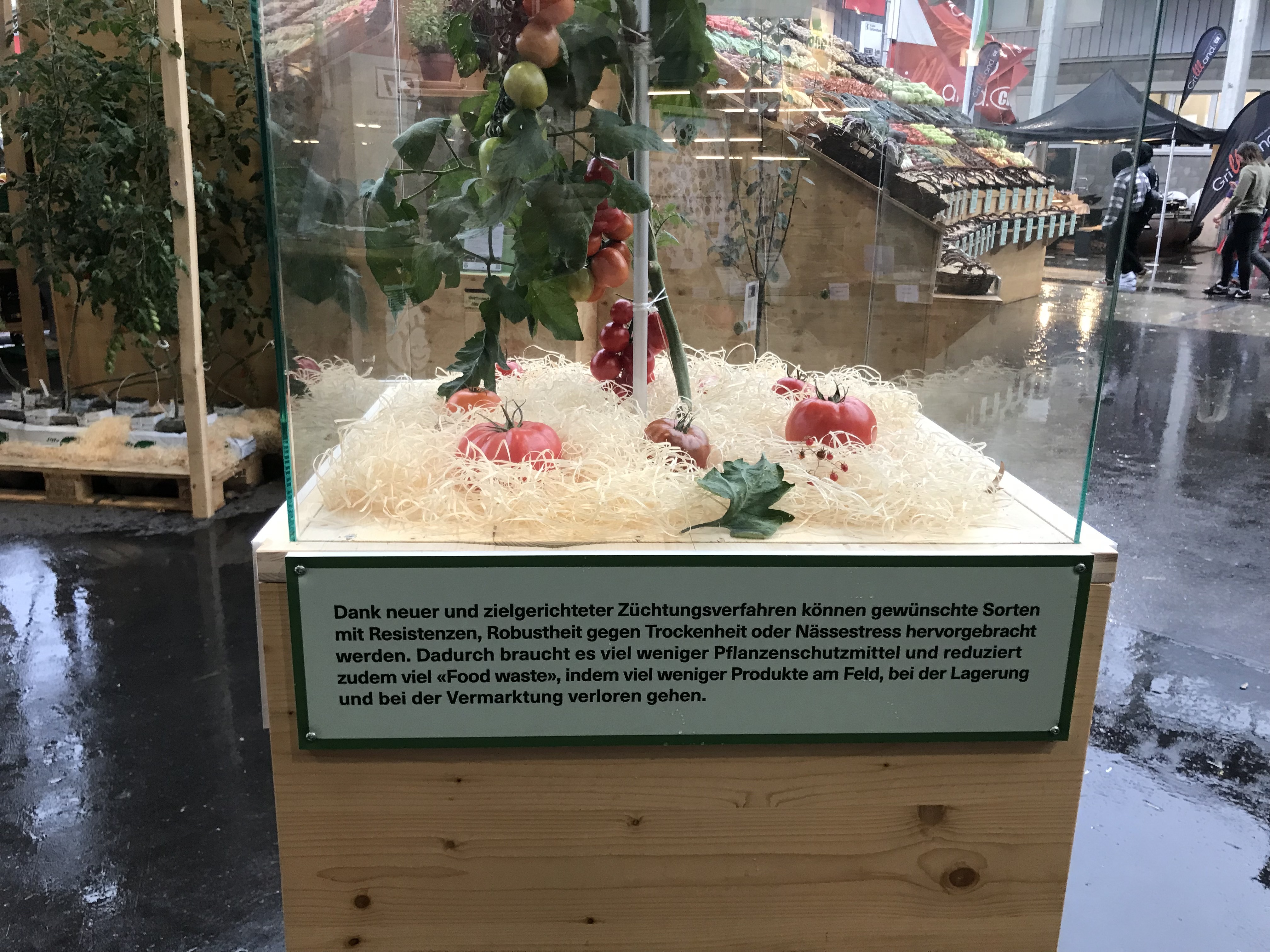
Tomatoes: From «water bomb» to aromatic fruit
The diversity of commercially marketed tomato varieties is greater today than ever before. This is mainly due to the breeding of new varieties. They are increasingly satisfying consumer demand for flavoursome fruit. It is not true that old varieties are supposed to be more flavoursome than new ones. Modern varieties are also perfectly suited to the climate-friendly and resource-efficient cultivation methods demanded by the trade.
Saturday, February 10, 2024
In brief
- For a long time, commercial tomatoes were considered to have little flavour. In Switzerland they were thus called «Wasserbomben» («water bombs»).
- This has changed fundamentally. The genetic diversity of different tomatoes has never been greater.
- New breeds will continue to play a decisive role in the future due to climate change and the need for resource-efficient cultivation methods.
No other vegetable in the world is as popular as the tomato (botanically, however, it is considered a fruit). Both production and the area under cultivation have roughly doubled in the past 25 years. This means that around 180 million tonnes of tomatoes are harvested worldwide every year. The largest producer by far is China (62.8 million tonnes), followed by India (19 million tonnes) and Turkey (12.8 million tonnes). Europeans eat around 35 kilograms of tomatoes per capita each year - 15 kilograms fresh and 20 kilograms processed.
«Water bombs»
The tomato was brought to Europe from South America by the Spanish at the beginning of the 16th century. The invention of products such as tomato ketchup and the advent of pizza in the 19th century popularised the tomato worldwide. Soon the production of the fruit was focussed on mass and no longer primarily on flavour. The focus was on breeding particularly high-yielding varieties, which over time led to genetic impoverishment. In the second half of the 20th century, the reputation of tomatoes began to suffer somewhat. They were often referred to as «water bombs» or «fourth aggregate state of water». The lack of flavour of «greenhouse tomatoes» was thus lamented.
Old varieties not more flavourful
Under the impression of the «water bombs», the general idea arose that older tomato varieties must be more flavourful. But this impression is misleading. Some time ago, the Agroscope research centre compared modern varieties with old varieties. New and old varieties were grown under exactly the same conditions. A team of experts who then tasted the tomatoes were unable to detect any differences between the old and new varieties. A study published in the scientific journal «Nature» in the early 2000s even came to the conclusion that the new tomato varieties had a better flavour.
Genetic diversity is increasing
The frequently lamented loss of flavour is more likely to be linked to the focus on high-yielding varieties and early harvests due to long transport routes.Aroma and flavour cannot fully develop if the tomatoes are harvested before they are ripe.Since the 1970s and 1980s, an increase in the genetic diversity of commercial tomato varieties has been observed again.New varieties have been increasingly bred to meet consumer demand for more flavourful tomatoes.Today, the range of tomatoes on offer is probably more diverse than ever before. From red to purple to black, everything is available. There is also considerable variety in terms of size and shape.
Breeding new varieties remains important
The demand for flavoured tomatoes will continue to increase in the coming years. Highly aromatic cocktail tomatoes and tomatoes with special pigmentation are particularly in demand. Breeding new tomato varieties will therefore remain a high priority in the future. Syngenta is one of the leading companies in the field of tomato breeding. Many of the multi-coloured cherry tomatoes available in Switzerland and the multi-award-winning Yoom tomato are the result of Syngenta's efforts. The «Kumato», also bred by Syngenta, is further proof that old varieties are no better than new varieties. The «Schweizer Familie» writes: «The dark green Kumato, for example, bred by the agrochemical company Syngenta, is tastier than the toothed tomato from Pro Specie Rara, the organisation that works to preserve old varieties.»
However, new varieties are not only important because of their flavour. Pest pressure and extreme weather events are increasing due to climate change. There is an urgent need to breed plants that are resistant to pests and weather. Syngenta can also report successes in this area: The company recently succeeded in breeding a tomato variety that is resistant to the Jordan virus. The great challenge in breeding is and remains achieving a combination of breeding goals: Disease and pest resistance, tolerance to drought or wetness, flavour, appearance, shelf life and - particularly important for tomatoes - transportability, for example through a firmer skin, which in turn must not be so firm that it impairs eating enjoyment.
Highly professional cultivation is required in order to guarantee consumers the same level of enjoyment. For example, the TIOR cultivation cooperative grows Yoom tomatoes for Coop 365 days a year in Ticino - in highly resource-efficient and climate-friendly greenhouses, as the customer Coop wants, and in the flavourful quality and local production that consumers desire.
No wonder, then, that the vegetable association also explained the advantages of genome editing such as CRISPR/Cas for modern vegetable cultivation in a joint product show at OLMA 2023 organised by many producer associations.

Digitalisation also supports highly professional, sustainable vegetable cultivation with individual plant monitoring, for example. Julien Stoll from Stoll Frères in Yverdon demonstrated this impressively at the swiss-food Talk on 3 May 2023.
Jordan virus in Thurgau
According to «BauernZeitung», the brown rugose fruit virus (ToBRFV or Jordan virus) was detected on a farm in the canton of Thurgau at the beginning of August 2021. It affects tomatoes and peppers, causing the fruit to turn an irregular yellowish to brownish colour. Damage up to total loss is possible. The Jordan virus is classified as a quarantine organism in Switzerland. Suspected cases must be reported. The virus can only be controlled by preventing its spread. Affected and neighbouring plants must be destroyed.
Kindly note:
We, a non-native editorial team value clear and faultless communication. At times we have to prioritize speed over perfection, utilizing tools, that are still learning.
We are deepL sorry for any observed stylistic or spelling errors.
Related articles

Residues, thresholds, trust – looking calmly behind the headlines
In this conversation with toxicologist Lothar Aicher, the discussion focuses on how residues enter the body, how their potential harm is assessed, and what role modern analytical methods play.

Hazard is not the same as risk: how we understand – and should understand – threshold values
In this episode of the podcast, risk researcher Angela Bearth discusses residues and threshold values in food – a topic often debated emotionally. In public discussions, threshold values tend to dominate, while the complex challenges of agriculture are rarely considered. Studies show, however, that once these relationships are explained and solutions are addressed, people respond in a more differentiated way.

PFAS, trade-offs and responsibility – how politics and agriculture find solutions
In this episode of the joint series by Agrarpolitik – der Podcast and swiss-food.ch, National Councillor Christine Badertscher discusses how residues and threshold values are debated in Parliament.

Thresholds, approvals, responsibility – how plant protection products are really assessed
Threshold values are often at the centre of public debate – yet in reality they are only a small part of a much broader risk assessment system. Dr Michael Beer, Head of the Food and Nutrition Division at the Federal Food Safety Office, provides clarity.

